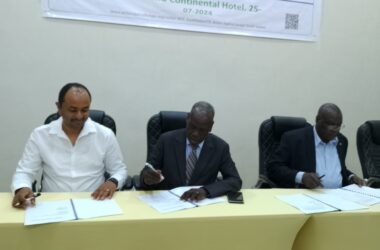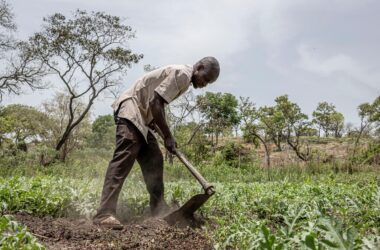By Mamer Abraham
Over 5.82 million people in South Sudan are experiencing acute food insecurity and malnutrition.
According to the latest Integrated Food Security Phase Classification (IPC) report, about 5.78 million people will also be food insecure during pre- and post-harvest periods, potentially by December 2023.
The report released by South Sudan gov’t and three United Nations agencies detailed that 7.1 million people would face crisis, emergency, and catastrophic levels of hunger in the next lean season of April to July, next year.
This is noted as a significant reduction from the expected 7.76 million people projected to be food insecure in the lean season, this year.
The report attributed the improvement to the prevalence of peace in some areas in Jonglei, Warrap, and Western Equatoria State.
The UNICEF Deputy Country Representative, Ismail Khan, said acute malnutrition was hitting the rooftops in 46 counties from July to September, unlike last year, when it was faced by 31 counties, showing a staggering increase of 15 counties.
“The situation is projected to worsen between April and June 2024, with the number of counties where acute malnutrition is critical projected to rise to 49 if no drastic measures are taken,” he noted with concern.
He stressed that the causes of acute food insecurity are attributable to diseases, poor childcare and feeding, inadequate healthcare, displacement related to floods, and conflict, including the recent war in Sudan.
He called for urgent action to curtail the impacts through continued and unrelenting provision of humanitarian assistance to the people.
Mr. Khan added that the nutrition sector needed up to $210 million, out of which $6.5 million will go to South Sudanese returnees who escaped the conflict in Sudan.
“More funding is needed to alleviate this critical acute malnutrition situation. The Nutrition Cluster partners need USD 210 million, including USD 6.5 million for South Sudanese returning from Sudan,” he continued.
Felix Dzvurumi, FAO South Sudan Deputy Country Representative, stated that acute food insecurity, as stated in the IPC report, was due to poor agriculture production.
“Granted, the challenges to the agriculture sector are many, and they range from climatic shocks that threaten progress made by South Sudanese farmers to a lack of quality seeds, poor post-harvest handling technologies, a weakened extension system, and the economic challenges that have not only affected this country. We need to work together to support the government in meeting the goals of the 2030 Agenda for Sustainable Development,” Felix argued.
He pledged UNFAO’s support to the agriculture sector for farmers to have a market to sell their farm produce as well as be able to buy other foods to balance their diet.
“The capacity building of national and subnational institutions that support the agriculture sector also needs special attention,” he continued.
“We need to come together from us in the agri-food system, those in the health, WASH, education, and social protection systems to address the malnutrition challenges in the chronic acute malnutrition hot spots and others that are emerging.”
Mary-Ellen McGroarty, WFP Country Director, noted the need to bolster food and nutrition programs next year with the purpose of saving lives and protecting human capital.
“This year there is some improvement in the situation as compared to last year; this is a welcome development,” she explains.
“However, food insecurity and malnutrition burdens remain at staggering levels. It is a crisis that has engulfed the country for a decade now.”
She stated that, in line with the report, 46 per cent of the populace would face a crisis level of food insecurity, while the returnees from Sudan would definitely be at a catastrophic level, stressing the need to address the root causes of food insecurity.
“At the peak of the lean season, it is projected that, again, over half the population, 56% of the population, will struggle to have access to food daily, and the number facing catastrophic levels of food insecurity will more than double. The results of the acute malnutrition situation are dire,” she continued.
“We will prioritize populations living with the most severe levels of food insecurity and malnutrition with a portfolio of interventions to address immediate needs,
Enable households and communities to build resilience, adapt to and mitigate the impacts of climate change, and protect human capital through nutrition programs and school meals that keep children in school,” she noted.
The WFP Country Director urged the government to prioritize zero hunger, education, health, and climate adaptation; speed up actions on nutrition; create a national budget to reflect the Maputo Declaration; and create an enabling environment for investment, financing, innovation, and markets to thrive in the private sector.
“With the generous support of our international partners, the World Food Programme and our sister UN agencies are here to empower the government and people of South Sudan on their journey to a better future,” she concluded.
For her part, the Minister of Agriculture and Food Security, Josephine Lagu, said the government must focus on the resilience program for the benefit of the local populace.
“Last year, the IPC report estimated that 7.76 million South Sudanese would face severe acute food insecurity between April and July this year. The new analysis points to a reduction of about 600,000 people in next year’s season of April to July 2024. This is worth noting,” Josephine said.
“These projected improvements assume peace prevails and the macroeconomic environment is stable with low inflation and a favorable exchange rate for the SSP.”
She continued that the Juba-Bor Road was paying incentives to the people in Jonglei State, hence the great benefit from rehabilitation and construction of roads.




